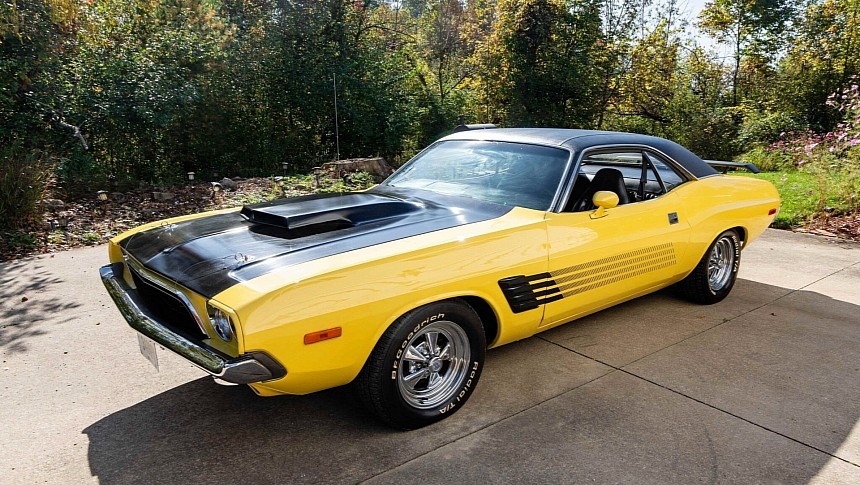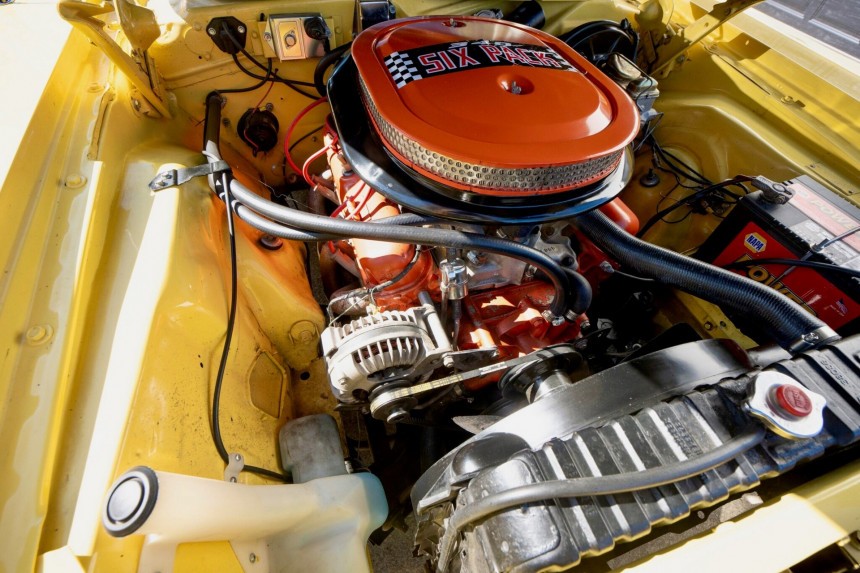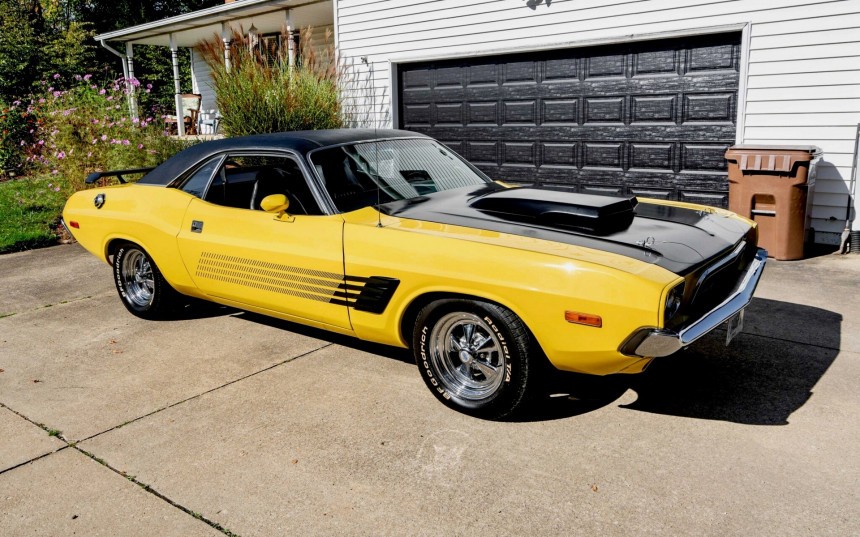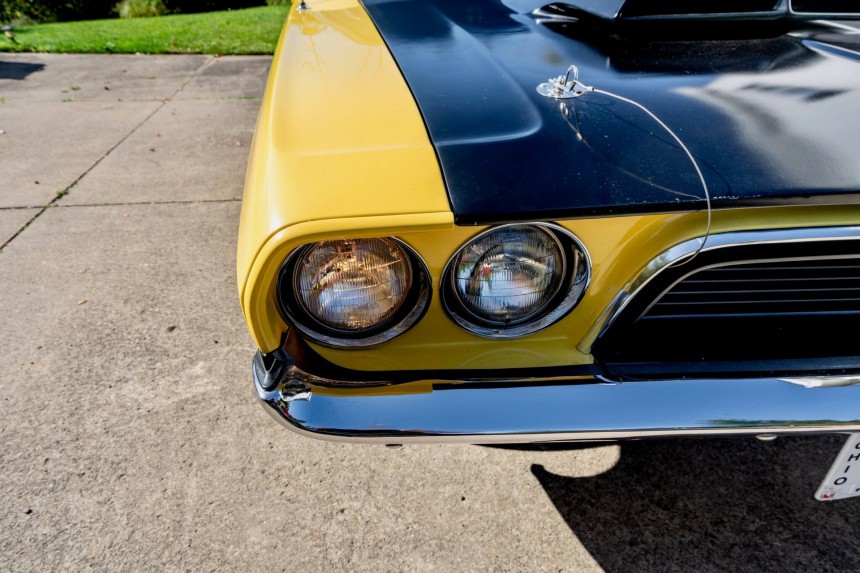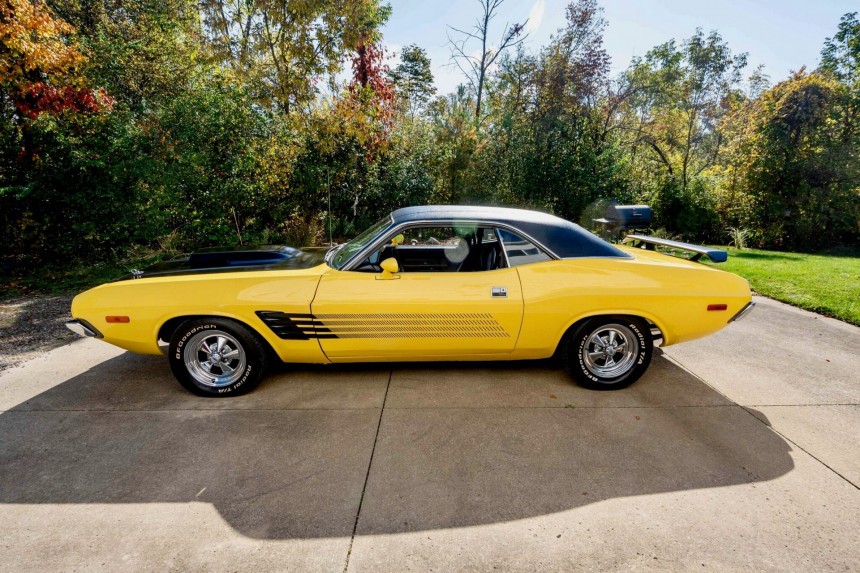By 1973, America was firmly set on its path to motoring misery for the next two decades, following a chain of events that can be traced back to the mid-sixties. Two things were becoming evident that year: muscle cars were history, and Mother Mopar wasn’t about to go down without a fight. After all, the Dodge Challenger had a nameplate to defend, even if its demise was imminent.
The Challenger showed signs of stage four misery a year before Chrysler pulled the plug on the emblematic model. Remember when it first hit the streets in 1970, the mighty Dodge was boasting no less than nine engine options? It only carried two offers three years later: the workhorse 318 cu-in (52-liter) V8 and a slightly more lively 340 CID (5.6 liters) eight-cylinder.
It was the same 340 that gained fame in the model’s inaugural year, albeit in a vastly different form: in 1970, the 340 V8 was armed with a trio of two-barrel carburetors in the Trans Am variant of the Dodge Challenger. Alongside it, the Dodge’s twin cousin from Plymouth, the Barracuda, was heralding the 340 on its All American Racers homologation edition, the AAR ‘Cuda.
But those were a one-year wonder, built specially so Chrysler could go around tracks in sanctioned events. In 1973, the 340 V8 was a pale remnant of the famous Six-Pack small-block, but it was still the best money could put in a factory Challenger.
Another notably sad experience in 1973 was the deteriorating performance extorted from those V8. With emissions equipment becoming mandatory and regulations smothering tire-vaporizing performance, the horsepower ratings nosedived. Dodge was fully aware of the waters it was swimming in, but it played its cards nonetheless.
Not that it had a good hand – the Challenger came in two versions, the base Challenger and the Rallye up-scale. But, as the sales literature had pointed out a year before, drivers might need not the world’s hottest car but a well-balanced, thoroughly instrumented road machine. (Right, and they say today’s EV craze is an exaggeration).
However, the public wasn’t fooled by any appearances, and the Challenger sales took the full blow. In ’73, Dodge didn’t surpass the 28,000-car milestone with its E-body pony car. Out of the 27,930 units assembled, 10,556 came in the Rallye garments.
Thanks in part to an infamous book that saw the light of print on the last day of November 1965 – Ralph Nader’s Unsafe at Any Speed – the federal government took severe action against motoring fun with a large-scale attack on the manufacturers’ positions. The book – accused mainly of having caused the death of one of America’s most ‘what if’ cars, the Chevrolet Corvair – spurred the birth of the EPA, the NHTSA, and a host of significant changes in the automotive universe.
So, it’s not entirely unsubstantiated to say that the 1973 Dodge Challenger was a collateral victim of that book. But even so, some hard-core fanatics pledged allegiance to the Mopar creed of performance and didn’t back down when the going got rough.
Quite the contrary, one of those cult members took the opposite approach: when motoring America was switching from muscle cars to personal luxury or other forms of automotive relief valves, one man decided it was the best time to buy himself a Challenger.
The year was 1978, and his eyes fell upon a Top Banana Rallye model – the one featured in the gallery. For these past 45 years, the two were inseparable, but now the proud owner made a heart decision and is letting his beloved Challenger go.
The car has had two owners in its entire 50-year life. It has also received a restoration that brought several modifications to the original broadcast sheet specifications. The most notable is that this Challenger is possibly the only ’73 Six-Pack in existence, thanks to the T/A triple carburetor setup sitting shamelessly under the T/A-style fiberglass hood.
Exhaust headers help to up the power output a little and make the engine sound more optimistic – listen to it in the attached video. The original hood with its blowhole dual air scoops is still with the car, should a buyer wish to put it back to its original form.
The 340 V8 is the factory-installed, matching-numbers block linked to a 3-speed automatic and a 3.91 Sure Grip rear. The TorqueFlite automatic transmission has been altered – or, more to the point, its lever has been moved from the column to between the bucket seats.
Being a true Rallye, the Tach and 150-mph speedo are standard offerings on the original dashboard. The missing link is the Music Master Radio AM – literally, the stereo is not in the car, and the lack of a block-off plate is one way of reminding the prospective new owner to start a treasure hunt for a replacement.
Considering the car’s short-list ownership, the 46,065 miles (74k km) shown on the clock are undoubtedly original, and the $11,550 offer with a week of bidding left is certainly not close to what the seller has in mind.
It was the same 340 that gained fame in the model’s inaugural year, albeit in a vastly different form: in 1970, the 340 V8 was armed with a trio of two-barrel carburetors in the Trans Am variant of the Dodge Challenger. Alongside it, the Dodge’s twin cousin from Plymouth, the Barracuda, was heralding the 340 on its All American Racers homologation edition, the AAR ‘Cuda.
But those were a one-year wonder, built specially so Chrysler could go around tracks in sanctioned events. In 1973, the 340 V8 was a pale remnant of the famous Six-Pack small-block, but it was still the best money could put in a factory Challenger.
Not that it had a good hand – the Challenger came in two versions, the base Challenger and the Rallye up-scale. But, as the sales literature had pointed out a year before, drivers might need not the world’s hottest car but a well-balanced, thoroughly instrumented road machine. (Right, and they say today’s EV craze is an exaggeration).
However, the public wasn’t fooled by any appearances, and the Challenger sales took the full blow. In ’73, Dodge didn’t surpass the 28,000-car milestone with its E-body pony car. Out of the 27,930 units assembled, 10,556 came in the Rallye garments.
So, it’s not entirely unsubstantiated to say that the 1973 Dodge Challenger was a collateral victim of that book. But even so, some hard-core fanatics pledged allegiance to the Mopar creed of performance and didn’t back down when the going got rough.
Quite the contrary, one of those cult members took the opposite approach: when motoring America was switching from muscle cars to personal luxury or other forms of automotive relief valves, one man decided it was the best time to buy himself a Challenger.
The car has had two owners in its entire 50-year life. It has also received a restoration that brought several modifications to the original broadcast sheet specifications. The most notable is that this Challenger is possibly the only ’73 Six-Pack in existence, thanks to the T/A triple carburetor setup sitting shamelessly under the T/A-style fiberglass hood.
Exhaust headers help to up the power output a little and make the engine sound more optimistic – listen to it in the attached video. The original hood with its blowhole dual air scoops is still with the car, should a buyer wish to put it back to its original form.
Being a true Rallye, the Tach and 150-mph speedo are standard offerings on the original dashboard. The missing link is the Music Master Radio AM – literally, the stereo is not in the car, and the lack of a block-off plate is one way of reminding the prospective new owner to start a treasure hunt for a replacement.
Considering the car’s short-list ownership, the 46,065 miles (74k km) shown on the clock are undoubtedly original, and the $11,550 offer with a week of bidding left is certainly not close to what the seller has in mind.
